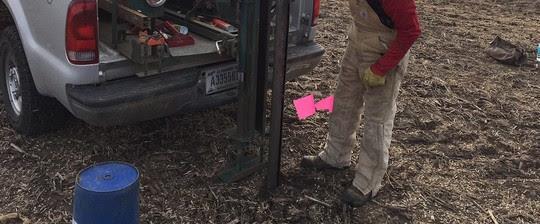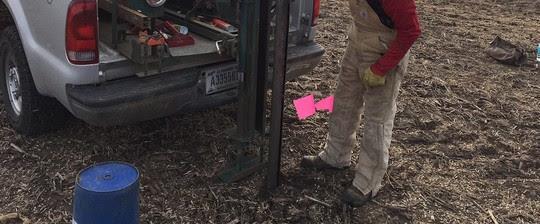
WASHINGTON – The U.S. Department of Agriculture (USDA) plans to invest $8 million to support and expand the monitoring of carbon in soil on working agricultural lands as well as assess how climate-smart practices are affecting carbon sequestration.
This is part of the Department’s efforts to build out a national soil carbon monitoring network, which was kicked off with soil carbon monitoring on Conservation Reserve Program (CRP) acres in 2021. USDA’s Natural Resources Conservation Service (NRCS) is requesting proposals for regional projects focused on soil organic carbon stock monitoring, which are due Nov. 28, 2022. This investment in building out the soil carbon monitoring network is part of the USDA’s comprehensive effort to address climate change through climate-smart agriculture and forestry.

“Healthy soils are a powerful tool when it comes to sequestering carbon. We want to enhance our measurement tools and integrate them into program delivery to advance quantification efforts of the effects that climate-smart agricultural practices have on carbon sequestration,” NRCS Chief Terry Cosby said. “Soil health management practices and activities are a tremendous part of our strategy when it comes to climate-smart agriculture and forestry.”
NRCS will fund four agreements, one in each region: Northeast, Southeast, Central, and West. Funding ranges from $1.5 to $2 million, and projects will last two to four years. Applications must include a strategy to reach equity in program delivery in historically underserved communities. Partners will work collaboratively to complement soil carbon monitoring efforts taking place across USDA.
NRCS is looking for projects that will:
- Deliver training on soil sampling for soil organic carbon and bulk density, data collection, and management and processing methods.
- Conduct outreach to producers to use NRCS’ soil carbon monitoring practice.
- Coordinate with NRCS national and state offices and centers to provide technical assistance.
- Identify and recruit specialists to help producers with implementing soil carbon monitoring.
- Reaching diverse producers to participate in soil carbon monitoring and other NRCS conservation activities.
Eligible entities include Tribal governments, nonprofits, universities, state and local governments, and members of the Cooperative Ecosystem Studies Units Network.
Additional information is available in the notice of funding, which will appear on grants.gov  in the coming days. Once the notice posts, NRCS will begin accepting applications via grants.gov. NRCS plans for a 60-day application window.
in the coming days. Once the notice posts, NRCS will begin accepting applications via grants.gov. NRCS plans for a 60-day application window.
New Soil Organic Carbon Stock Monitoring Conservation Evaluation and Monitoring Activity
Beginning in fiscal 2023, NRCS will offer a new conservation evaluation and monitoring activity (CEMA) to provide assistance for measuring soil organic carbon stocks. The new activity is used to quantify the levels of organic carbon stored in the soil and monitor the change in soil carbon stocks before and after the implementation of a conservation practice or conservation plan.
A qualified individual will use a hydraulic probe to sample soil to a one-meter depth. The soil will then be tested for organic carbon and bulk density to provide organic carbon stock levels to farmers and ranchers. Partners will play a critical role in training individuals on the sampling methodology as well as conducting outreach to producers to inform them of the opportunity through NRCS.
More Information
These partnerships are part of USDA’s broader effort to leverage the expertise, experience, and capacity of other organizations to address climate change and broaden the footprint of climate-smart agriculture. For example, USDA’s Farm Service Agency (FSA) is investing $10 million in its Monitoring, Assessment, and Evaluation effort to sample, measure, and monitor soil carbon on CRP acres to better quantify the climate outcomes of the program.
More broadly, USDA announced earlier this month its plans to invest up to $2.8 billion in 70 selected projects under the first pool of the Partnerships for Climate-Smart Commodities funding opportunity, with projects from the second funding pool to be announced later this year. Ultimately, USDA’s anticipated investment will include more than $3 billion in pilot projects that will create market opportunities for American commodities produced using climate-smart production practices.
Meanwhile, the Inflation Reduction Act (IRA) will also deliver $19.5 billion in new conservation funding to support climate-smart agriculture. This historic funding includes approximately $20 billion to support conservation programs that are oversubscribed, meaning that more producers will have access to conservation assistance that will support healthier land and water, improve the resilience of their operations, support their bottom line, and combat climate change. This includes $8.45 billion for the Environmental Quality Incentives Program, $4.95 billion for the Regional Conservation Partnership Program, $3.25 billion for the Conservation Stewardship Program, and $1.4 billion for the Agricultural Conservation Easement Program. The IRA also provides $300 million to support the quantification of carbon sequestration and greenhouse gas emissions reductions, directly tied to the conservation program investments. The agreements funded through today’s announcement will be complimentary to these quantification efforts and monitoring across the Department.
USDA touches the lives of all Americans each day in so many positive ways. In the Biden-Harris administration, USDA is transforming America’s food system with a greater focus on more resilient local and regional food production, fairer markets for all producers, ensuring access to safe, healthy, and nutritious food in all communities, building new markets and streams of income for farmers and producers using climate-smart food and forestry practices, making historic investments in infrastructure and clean energy capabilities in rural America, and committing to equity across the Department by removing systemic barriers and building a workforce more representative of America. To learn more, visit usda.gov.



